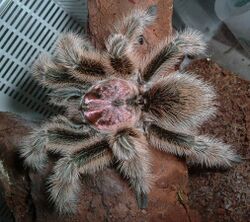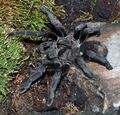Biology:Grammostola
| Grammostola | |
|---|---|

| |
| Male Grammostola rosea | |
| Scientific classification Error creating thumbnail: Unable to save thumbnail to destination
| |
| Domain: | Eukaryota |
| Kingdom: | Animalia |
| Phylum: | Arthropoda |
| Subphylum: | Chelicerata |
| Class: | Arachnida |
| Order: | Araneae |
| Infraorder: | Mygalomorphae |
| Family: | Theraphosidae |
| Genus: | Grammostola Simon, 1892[1] |
| Type species | |
| G. pulchripes (Simon, 1891)
| |
| Species | |
|
20, see text | |
| Synonyms[1] | |
Grammostola is a genus of South American tarantulas that was first described in text by Eugène Louis Simon in 1892.[5] These medium- to large-sized spiders are native to tropical South America, and are usually brown in color, with pinkish or orangish-red hairs. The very docile Chilean rose tarantula (Grammostola rosea) is popular as a beginner's spider among tarantula enthusiasts.[6]
Grammostola as a pet
The Chilean rose tarantula (Grammostola rosea) is a common pet, as its behavior is generally docile and its venom is very mild. It needs to be kept dry and dislikes being wet (its natural habitat is one of the driest deserts on earth). If the substrate is too wet, it will stand "on tiptoes" in discomfort, or climb the sides of its enclosure, risking fall and injury. It feeds on other invertebrates. Its attributes and care are similar to those of its relative, the Chaco golden-knee tarantula (Grammostola pulchripes).[citation needed]
Species
(As of January 2024) it contains twenty species, found in South America:[1]
- Grammostola actaeon (Pocock, 1903) – Brazil , Uruguay
- Grammostola alticeps (Pocock, 1903) – Uruguay
- Grammostola andreleetzi Vol, 2008 – Uruguay
- Grammostola anthracina (C. L. Koch, 1842) – Brazil , Uruguay, Paraguay, Argentina
- Grammostola borelli (Simon, 1897) – Paraguay
- Grammostola burzaquensis Ibarra, 1946 – Argentina
- Grammostola chalcothrix Chamberlin, 1917 – Argentina
- Grammostola diminuta Ferretti, Pompozzi, González & Pérez-Miles, 2013 – Argentina
- Grammostola doeringi (Holmberg, 1881) – Argentina
- Grammostola gossei (Pocock, 1899) – Argentina
- Grammostola grossa (Ausserer, 1871) – Brazil , Paraguay, Uruguay, Argentina
- Grammostola iheringi (Keyserling, 1891) – Brazil
- Grammostola inermis Mello-Leitão, 1941 – Argentina
- Grammostola mendozae (Strand, 1907) – Argentina
- Grammostola pulchra Mello-Leitão, 1921 – Brazil
- Grammostola pulchripes (Simon, 1891) (type) – Paraguay, Argentina
- Grammostola quirogai Montes de Oca, D'Elía & Pérez-Miles, 2016 – Brazil , Uruguay
- Grammostola rosea (Walckenaer, 1837) – Bolivia, Chile , Argentina
- Grammostola subvulpina (Strand, 1906) – South America
- Grammostola vachoni Schiapelli & Gerschman, 1961 – Argentina
In synonymy
Transferred to other genera
Grammostola familiaris (Bertkau, 1880) → Homoeomma familiare
Nomen dubium
Grammostola monticola (Strand, 1907) - Bolivia
Gallery
See also
References
- ↑ 1.0 1.1 1.2 Gloor, Daniel; Nentwig, Wolfgang; Blick, Theo; Kropf, Christian. Gen. Grammostola Simon, 1892. Natural History Museum Bern. doi:10.24436/2. http://www.wsc.nmbe.ch/genus/3357. Retrieved 2024-01-05.
- ↑ Schmidt, G. (1994). "Das Männchen von Tapinauchenius gigas di Caporiacco, 1954 (Araneida: Theraphosidae: Aviculariinae)". Arachnologisches Magazin 2 (5): 5.
- ↑ Bertani, R.; Fukushima, C. S. (2004). "Polyspinosa Schmidt, 1999 (Araneae, Theraphosidae, Eumenophorinae) is a synonym of Grammostola Simon, 1892 (Araneae, Theraphosidae, Theraphosinae)". Revista Ibérica de Aracnología 9: 330.
- ↑ Raven, R. J. (1985). "The spider infraorder Mygalomorphae (Araneae): Cladistics and systematics". Bulletin of the American Museum of Natural History 182: 159.
- ↑ Simon, E (1892). Histoire naturelle des araignées. Paris: Roret. doi:10.5962/bhl.title.51973. https://www.biodiversitylibrary.org/bibliography/51973.
- ↑ Muller-Esnault, Susan, DVM. "Rose Hair Tarantulas or Chilean Rose Hair" (2008). http://www.critterology.com/rose_hair_tarantulas_or_chilean_rose_hair-192.html
External links
- Rehak, Ondrej, Gallery of tarantulas, http://www.spidy.goliathus.com/english/gallery-tarantulas.php, retrieved 2016-01-24 – includes Grammostola species
- LiveScience Wild Tarantula Eats a Foot-Long Snake in a First
Wikidata ☰ Q139240 entry
 |




